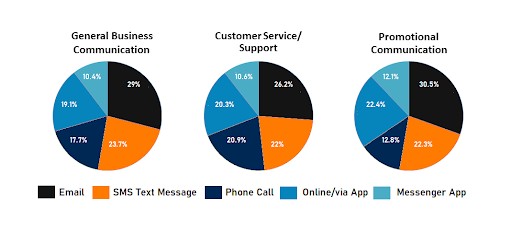Highlights:
- Today’s customers expect contact centers to offer multiple communication channels, both physical and digital.
- Contact centers need the right communications solution to provide a seamless omnichannel customer experience.
- A digital-first communications solution gives agents the tools they need to service customers effectively.
Why is it important to position your contact center as a digital leader? Simply put, it’s what your customers want from you.
Today’s customers expect—even demand—that you provide them with their preferred methods for communication for your brand. Increasingly, those preferred channels are digital. According to a recent CMO Council survey, 85 percent of survey respondents said that they expect companies to offer a blend of physical and digital communication channels.
The proportions in that blend depend largely on the age of the respondent. For example, customer experience research by Dimension Data revealed that:
- 32% of respondents less than 25 years of age prefer social media for communication with organizations, compared to less than 35 of respondents 55+
- Of those who prefer messaging, 5% of respondents were 35-54 years old, 20% were 25-34 years old, and 18% were less than 25 years old
- Communicating via mobile apps was preferred by 6% of 35-54-year-olds, 22% of 25-34-year-olds, and 27% of those less than 25 years of age.
Age is not the only factor that impacts communication preferences. According to a survey completed in late 2020, the reason for the communication is also a factor, as illustrated in these graphs:

As all these statistics show, digital communication channels are here to stay. The question is, how can you ensure that your contact center is a digital leader?
👩💼 💫 Teamwork makes the dream work 💫 👨💼
The key to building a customer-centric team: Enterprise edition eBook
Here are six essential steps:
1. Own the digital channels
In many companies today, the contact center does not manage the digital channels offered to customers. Those channels may be managed by sales or marketing. The problem is that when customers contact your brand, in most cases, they are likely looking for customer service.
Rather than being shunted from one department to another, your customers will have a far better experience if customer service owns the monitoring and engagement with customers via digital channels upfront. That ensures that a customer’s first point of contact is a trained contact center agent, who will be focused on providing the best customer experience possible.
Additionally, agents handling omnichannel interactions will be able to include other channels when appropriate for the customer and able to capture feedback that can be passed on to the appropriate departments to ensure data silos do not exist.
2. Use the right solution to support digital channels
If you want to be a digital leader among contact centers, you need a solution that can support all your digital channels seamlessly. Your communications solution should make it easy and cost-effective for you to add channels as the need arises and enable your agents to manage interactions between channels.
Not all communications solutions allow for this kind of flexibility and this level of support for omnichannel communications. Because digital channels are not standardized and vary widely in terms of both user interface and capabilities, the solution you choose must have strong integration capabilities.
3. Pay attention to agent experience
If your agents aren’t happy, your customers will not be happy either. Empower your agents to succeed as digital leaders by giving them the tools they need to manage omnichannel interactions.
One essential tool is a unified inbox, which allows agents to handle all interactions, regardless of channel, from one centralized location. Rather than siloing your agents according to a specific channel (ie., voice vs digital), train and equip agents to become proficient with all channels. This will enable your agents to offer customers a rich, omnichannel experience.
Look for a solution that allows agents to work with each channel with its native features intact. This helps agents meet customers “where they are” and provide a familiar, comforting experience to them.
Handling multiple digital channels is easier for your agents when they’re allowed to get their work from a dynamically prioritized queue rather than simply answering the next call that comes down the pike.
In these ways, you build a unified agent experience that results in greater agent and customer satisfaction.
4. Give agents customer context
There are few contact center experiences as frustrating as being shunted from one agent to another and having to repeat the details of the issue about which a customer is reaching out. It is frustrating both for the agent and for the customer.
Eliminate this frustration by providing customer context to your agents. Digital leaders in the contact center space give agents access to customer data such as customer history, previous customer contacts across channels, and even current customer sentiment.
By providing agents with contextual information, you empower them to better handle omnichannel interactions. With immediate access to conversation history regardless of channel, agents are better prepared to provide a great customer experience before they even begin their interaction with the customer.
5. Provide a smooth ride on the omnichannel journey
When all is said and done, what your customers really want is to resolve their issues with the least amount of friction and frustration. The beauty of the Digital Age is that you can provide a smooth customer journey when you become proficient in handling omnichannel transactions.
For example, suppose your customer contacts your agent by phone about a billing issue, stating that he is being billed a second time for something for which he has already paid, and he has the bank statement to prove it.
Your agent can easily direct the customer to snap a quick picture of the bank statement and send it via text or his preferred app. The customer complies easily, sending along the statement while he’s still on the phone. Your agent reviews the statement and makes adjustments in the customer’s file to reflect the payment. The customer hangs up feeling happy and relieved, and your agent sends the appropriate notes and documentation to the billing department. Both your agent and customer are happy with the interaction.
6. Power self-service with AI
Although you want your agents to be omnichannel superstars, do not neglect to give them additional support in the form of self-service options powered with AI. Just as interactive voice response (IVR) systems support voice channels, chatbots support digital channels.
Deploy well-designed chatbots to walk customers through self-service options, and leverage intelligent routing to live agents when the situation merits it. Be sure to enable customers who choose a self-service option to opt out of self-service in favor of working with a live agent when they want to do so.
Don’t forget to use AI on the back end of interactions as well. Bots can be used for simple post-processing activities to free up agent time for more high-value interactions.
Become a digital leader with RingCentral
RingCentral is a cloud-based communications platform that enables organizations to provide excellent digital-first omnichannel experiences. To see our contact center solution in action, request a demo.
To read more about how to evolve your contact center to become a digital leader, download the ebook entitled “The Innovator’s Guide to the Digital First Contact Center.”

Originally published Jan 03, 2022, updated Dec 30, 2022





